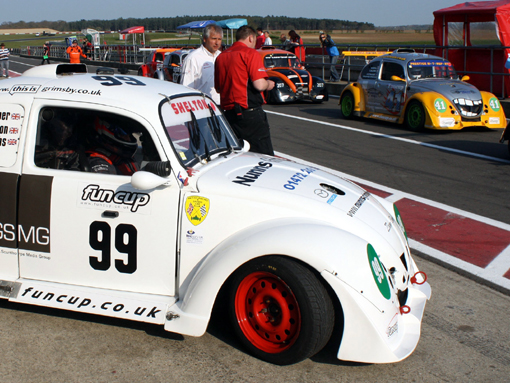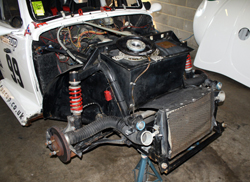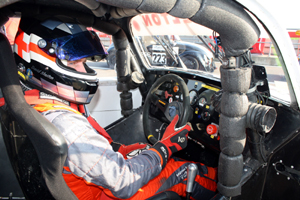Fun Cup practice proves an eye-opener
The big moment had arrived, we’d met our team mate and seen Car 99 for the first time, but as wheelworldreviews Editor DAVID HOOPER reports, after our first practice session, we realised we’d have to improve our lap times to be competitive.
WITH a mix of excitement and apprehension ahead of our Fun Cup race, we arrived at Snetterton Race Circuit, not far from Norwich, in Norfolk, at around 10am, armed with our shiny new race licences and a boot full of stickers to decorate Car 99 with.
We each had one race under our belts – I had raced an RX-8 at Snetterton for Mazda UK in 2005, and Jeremy Griffiths, the boss of Grimsby’s Nunns Mazda and Mitsubishi dealerships, was fresh from his win in an MX-5 for Mazda’s Team UK in Italy earlier this year, when he competed in an endurance race to celebrate the 20th birthday of the MX-5.
We made our way to Pit Garage number 4 to see the car we would be racing for the first time. Dave Shelton, our team’s third driver, was already there. An experienced racing driver, with over 60 single-seater races to his name, he only confirmed his drive a couple of days before the event. He had competed in Formula Vee and Formula Ford, Power nights in Formula Ford, F4 in a Van Diemen Renault, tested in Spanish F3, raced in F4 in Renault and the Formula Palmer Audi Autumn Trophy, as well as F4 Van Diemen last year.
We also met Scott, our Fun Cup mechanic who would look after our car during the weekend.
After a visit to the circuit office to get signed on, we found Paul Rose who runs the Fun Cup series in the UK and introduced ourselves. He went over the car with us and explained its controls and what all the markings on the various dials meant, how to adjust the brake balance if we needed to in the race and warned us not to be too rough with the gearbox in case we destroyed the synchromeshes. “Pretend you’re going to the supermarket,” he said.
We were due out on track for our first practice session at 12.35, so it was soon time to get changed into our race suits and fire-proof underwear.
We only had an hour for the three of us to drive the car, so by the time each driver came into the pits, clambered out of the car, and the next was strapped in and away, we had around 15 minutes of track time each. We decided we would let the most experienced racer go first, so Dave Shelton clambered into the seat and we got him strapped in and watched him head out of the pits for the first time.
The Fun Cup cars are designed and built by Dubois Racing, in Belgium and there are now two classes, the 1.8-litre petrol models we were racing with 130bhp engines, and diesel engined cars, with 170bhp.
They may look like VW Beetles, but that’s only a silhouette – under their Glass Reinforced Plastic (GRP) skins, they are proper racing cars with space frame chassis.
The engine is based on the MkII Golf GTi power plant and is mated to a gearbox that originated in an Audi 80. The engine is mid-mounted, between the driver and the rear wheels for good balance, and although they may not sound that powerful, the cars only weigh 760kg, which means they have a good power to weight ratio and are surprisingly fast.
The petrol tank which has to meet FIA standards, sits between the driver and the front axle, with access for refuelling on top of the bonnet, while the driver, who sits in the middle of the car is protected by an oversized roll cage and a five-point racing harness.
Fun Cup cars use Uniroyal RainSport tyres, which provide plenty of grip in wet and dry conditions.
For easy access to the engine and gearbox, the section of the body behind the B-pillar hinges backwards while the rest of the panels are mounted to the chassis with snap-lock fasteners. The engine and gearbox are sealed to ensure close racing, so the suspension is one of the few things that can be adjusted.
Dave’s first stint in the car was soon finished and as he came into the pits I was ready for my go. He told Scott the car was understeering and there was too much feedback through the steering wheel. As Scott set about adjusting the tyre pressures which had gone too high as the tyres warmed up, I clambered into the car and headed out of the pit lane and onto the circuit for the first time in five years. I thought I had remembered it quite well, but it was very different in some places, and the circuit owners, MotorSport Vision, who also own Cadwell Park, had recently finished resurfacing parts of the track, so we were warned that grip levels may not be that good on the new surfaces. We also had to watch out for some new kerbs in some corners.
My first few laps were quite tentative as I got used to the car – and began to build up my pace gradually, but much of the time was spent keeping out of the way of some of the other cars – and not just the diesels either.
The mirrors on the cars are small and difficult to see out of, and other cars seemed to appear behind me from nowhere.
I enjoyed my first run, but 15 minutes on the circuit was enough. It was a hot day with little air in the car, and with no power steering and race-prepared brakes it was quite a work-out. Modern cars are obviously making us soft!
I was glad to have survived the first session in one piece, and after I was dragged out of the car in practice for our quick driver changes in the race, Jeremy took his first turn at the wheel.
He also had an incident free run, but never having driven the circuit before found it hard to find the right lines.
Snetterton is a difficult circuit to learn. Riches, the first corner, is a sweeping double apex affair, while Coram, at the end of the track, is a massive, high-speed right-hander – get the wrong line through there and you’ll be heading off piste at 80 or 90mph – definitely not recommended.
At the end of the first practice session, our times were fairly similar at around 1min 36/38secs. The fact that last year’s pole position time was around 1min 25secs made us realise we had a lot of work to do to get near race pace.
The rest of the afternoon was spent putting our decals on the car. Large Grimsby Scunthorpe Media Group stickers went on the right hand side, and Lincolnshire Media on the left, while Nunns Grimsby and Mazda and Mitsubishi logos went on the bonnet and boot, while Dave’s surname was emblazoned on the sun strip and the rear spoiler. A couple of Zoom-Zoom stickers on the outside edges of the rear spoiler were the finishing touches.
When we’d finished the car looked great, and it was almost time for our second hour of practice, from 5.15-6.15pm.
We followed the same order on track, and all our times improved gradually, but none of us could break the 1min 30sec mark. Jeremy got the closest of the three of us, with a 1min 30.6secs. Dave Shelton and I weren’t far behind, but Dave was used to racing smooth single seaters and was finding the transition to the higher seating position of a saloon car, and very different driving characteristics a challenge.
With some of the quicker cars nearing last year’s pole position time, we thought we may well be starting from the back of the grid come race day.
We only had our qualifying session, another 15 minutes of track time each, to find almost five seconds per lap! When you are already driving as fast as you dare, that’s a big ask!
Find out how Fun Cup qualifying works, what grid position we got, and how the race went in my next instalment.




